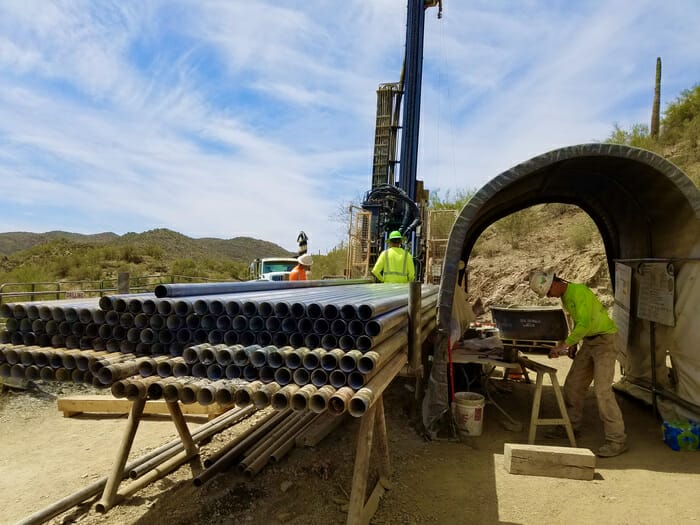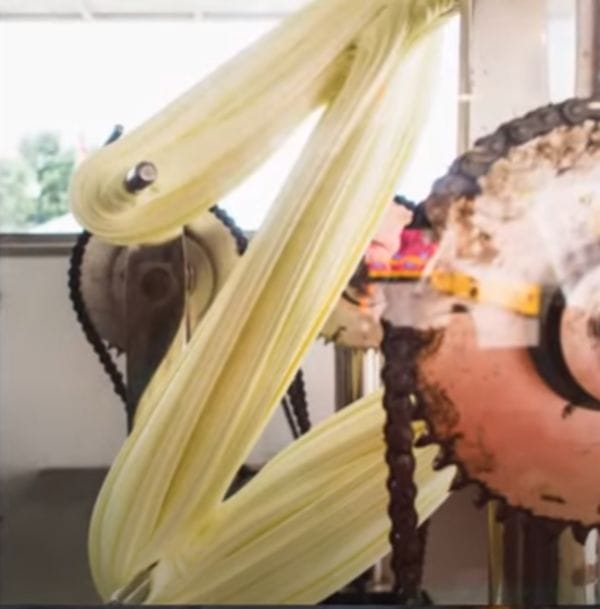On May 19th, Arizona Metals announced the discovery of a new gold-rich zone of open-ended mineralization at its Kay Mine project in mining-friendly Arizona:
Highlights from that May 19th press release:
- Hole 25 intersected 79 meters of 7.0 g/t AuEq, including two separate higher-grade intervals of 9 meters grading 18.1 g/t AuEq and 11 meters grading 14.7 g/t AuEq (from a vertical depth of 638 meters).
- Hole 24 intersected 91 meters of 4.7 g/t AuEq, including two separate higher-grade intervals of 20 meters grading 9.2 g/t AuEq and 16 meters grading 6.8 g/t AuEq (from a vertical depth of 470 meters). This hole also intersected a high-grade interval of 0.8 meters grading 33.4 g/t AuEq.
Those were some fat hits. The weight of those intervals generated the kind of share price trajectory we are all looking for in this high-risk / high-reward arena.
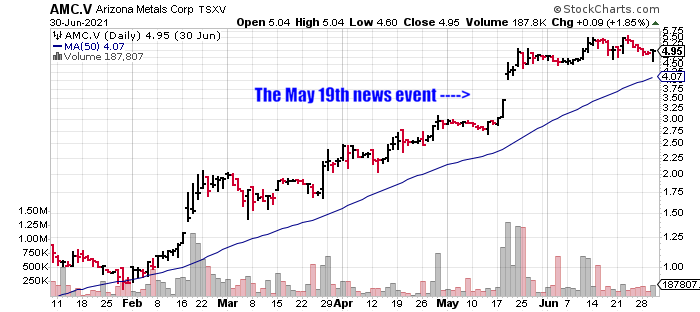
The flagship asset
AMC’s flagship—the Kay Mine project—is located in a prolific mining district in Arizona, a world-class jurisdiction currently ranked #2 by the esteemed Fraser Institute (Arizona is responsible for roughly 10% of the world’s copper production btw).
This region has produced a bounty of mineral wealth during its century-long run. No less than 60 past-producing underground Cu-Au-Zn VMS mines, good for ~4 billion pounds of copper, are all within a 150-kilometer radius of Kay.
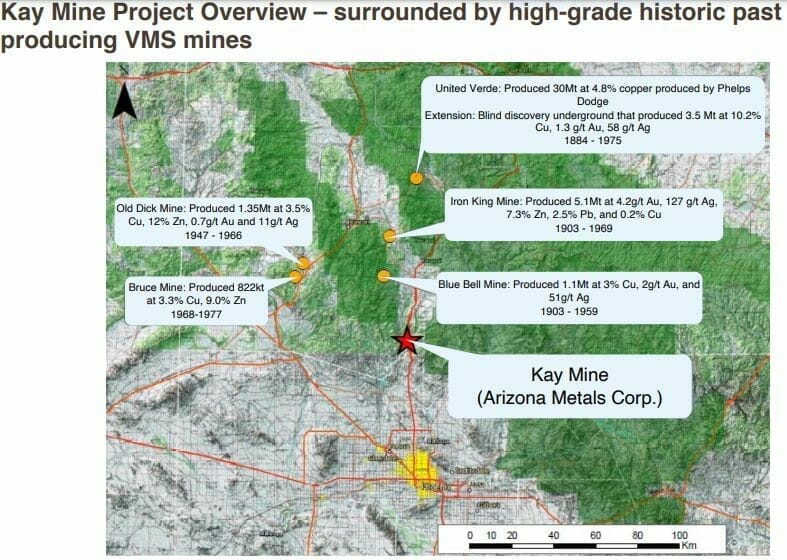
These are Volcanic Massive Sulphide (VMS) deposits. Quoting my recent coverage relating to the prolific, high-grade nature of these unique ore bodies…
“Spawned by volcanic hydrothermal events in submarine environments, they almost always occur in clusters—where there’s one deposit (or lens)… there are often others. And though they can vary in scale—ranging from one million all the way to 100 million tons—these polymetallic orebodies can hold huge concentrations of metals due to their rich nature.”
There’s also a (historic) resource at Kay. In the early 1980s, Exxon Minerals reported a “proven and probable reserve of 6.4 million short tons at a grade of 2.2% copper, 2.8 g/t gold, 3.03% zinc, and 55 g/t silver.” ***
The following, recently highlighted in a Guru roundup, further explores the unique geology underpinning Kay’s subsurface stratum…
The Kay Mine is what’s known as an Isoclinal Folded Deposit. A good illustration of this folding sequence is offered by Quinton Hennigh, comparing Kay’s underlying geology to that of a taffy pull—the following vid beginning at 26:40…
Crescat Gets Activist on Gold & Silver #32 – Arizona Metals Corp ($AMC.V)
The Kay Mine belongs to a classic VMS setting where high grades are a dominant feature. “Birds of a feather”—if high grades are present in one deposit, that feature should repeat itself in other deposits throughout the district.
In the above vid, Hennigh opines that the high-grade gold component at Kay may be indicative of scale—”usually the big ones are the ones that have high-grade gold“.
Another FAT batch of assays
On June 30th, the Company followed up the May 19th values with another batch of impressive assays:
Here, the Company trotted out assays for an additional four holes from the recently discovered (open-ended) gold-rich zone spotlighted in the May 19th press release—an area untested by historic drilling or exploration.
Highlights:
- Branch Hole 21A intersected 63 m at a grade of 1.3 g/t Au, 3.1% Zn, 0.5% Cu, and 59 g/t Ag., including a higher-grade interval of 16.9 m grading 2.5 g/t Au, 4.1% Zn, 0.5% Cu, and 81 g/t Ag. Further up-hole, 21A also intersected 9.4 m grading 0.6 g/t Au, 2.3% Zn, 1.2% Cu, and 9 g/t Ag. Hole 21A entered mineralization at a vertical depth of 362 m.
- Branch Hole 25A intersected 65 m of 1.9 g/t Au, 2.2% Zn, 1.0% Cu, and 19 g/t Ag, including two separate higher-grade intervals of 7.3 m grading 2.1 g/t Au, 1.9% Zn, 3.7% Cu, and 30 g/t Ag, and 6.1 m grading 8.0 g/t Au, 3.7% Zn, 2.7% Cu, and 37 g/t Ag, from a vertical depth of 620 m.
- Hole 25A is a branch from hole 25 (79 m at 2.3 g/t Au, 2.8 % Zn, 1.4 % Cu and 43 g/t Ag), and is located 30 m north and 25 m above hole 25, in order to test both the lateral extension and vertical continuity of mineralization.
- Hole 25B intersected 4.3 m grading 0.9 g/t Au, 0.9% Zn, 0.9% Cu, and 25 g/t Ag, within a broader 35 m interval of stringer to semi-massive sulphide mineralization.
- Hole 26 intersected 76 m grading 1.6 g/t Au, 4.2% Zn, 0.8% Cu, and 33 g/t Ag, including two separate higher-grade intervals of 14.9 m grading 1.8 g/t Au, 9.7% Zn, 0.7% Cu and 43 g/t Ag, and 9.0 m at 6.1 g/t Au, 4.0% Cu, 3.3% Zn, and 18 g/t Ag, from a vertical depth of 475 m. This hole was targeted to test a zone located 50 m below hole 24 (91 m at 1.3 g/t Au, 3.4 % Zn, 0.5 % Cu, and 44 g/t Ag), but due to excessive flattening while drilling, ended up at a similar elevation to hole 24, but 15 m to the north.
Multiple high-grade (sub) intervals characterize the broader intercepts.
Importantly, this new gold-rich zone is tying together nicely, demonstrating both lateral and vertical continuity.
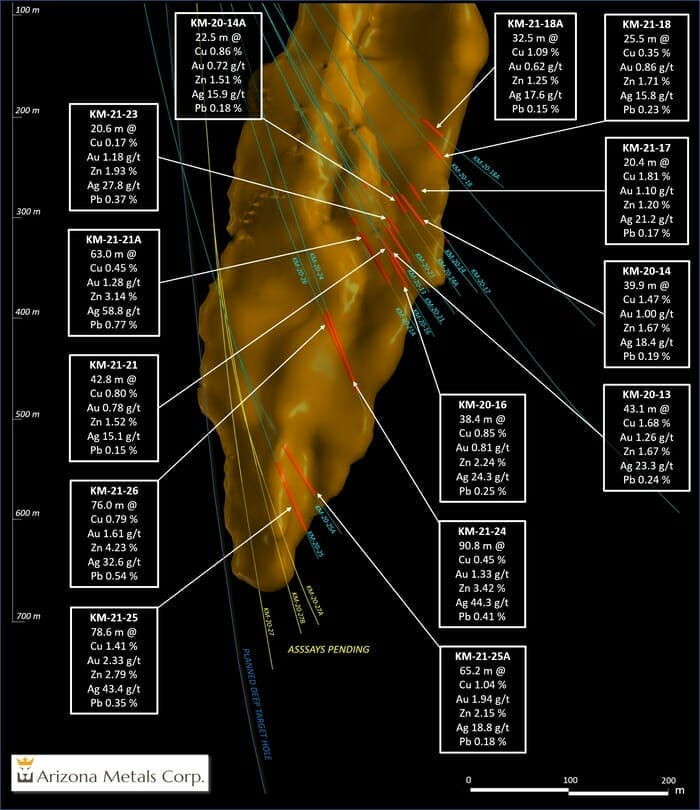
Marc Pais, CEO:
“The four drill holes released today validate and extend the new gold-rich zinc zone discovery, with broad intervals of mineralization ranging from 63 m to 76 m, and true widths estimated at an average of 80%. Hole 27 (assays pending) demonstrates that mineralization extends at least 100 m deeper than reported by previous operators. Holes 27A and 27B (assays pending) have encountered semi-massive to massive sulphide mineralization at thicknesses similar to those reported in the discovery holes, while also demonstrating the potential for the discovery zone to both extend at depth and increase on strike as it deepens. The first few holes drilled in the discovery zone were on a large step-out spacing of 100 m to 150 m. Subsequent branch holes to infill between these holes are demonstrating excellent vertical continuity, as well as lateral extension of mineralization on strike to both the north and south. Holes at the lab with assays pending, as well as those currently in progress, and planned, are targeted at aggressively testing the expansion potential of this new discovery. A third drill rig was delivered to site earlier this month, and is currently drilling a target located 500 metres north of the Kay Mine. With the recently completed financing of $21 million, the Company is fully-funded to complete the 75,000 metre Phase 2 expansion program.”
Amplifying CEO Pais’s comments…
- Hole 27 (assays pending) is located approximately 110 meters below hole 25.
- Branch hole 27A (assays pending) was drilled at the same elevation as hole 27, but 110 meters to the south.
- Hole 27B (assays pending), designed to test the depth extensions of the high-grade gold-zinc values observed in holes 21A, 24, 26, 25, and 25A, was drilled 50 meters to the south of hole 27.
- Hole 28 (assays pending) targeted an area located 100 meters above hole 25 and 100 meters north of hole 25B.
The bulk of the mineralized intervals in holes 21A, 25A, and 26 are located between the North and South zones, outside the (historic) resource defined by Exxon. Historical records show minimal exploration in this area by previous operators. Hole 27 was drilled 110 meters deeper than hole 25 and is 400 meters deeper than 21A.
The lab is due to deliver a substantial volume of assays from this new zone in the short term (we stand to watch).
These newly defined high-grade intervals of gold-zinc mineralization stand to add significant tonnage—meaningful (gold) ounces and (zinc) pounds—beyond the limits of the historic resource base, which is predominantly copper-gold in composition.
Kay Mine Permitting Update and the Addition of a Third Drill Rig
A third diamond core drill rig was delivered to the site on June 9th and began turning at Pad 4, located 500 meters to the north of the main deposit (top right, map below). Here, the drill bit is probing a shallow historic intercept of massive sulphides (alternating copper, zinc, and gold values) coincident with anomalies—structural and gravity—identified by Arizona Metals.
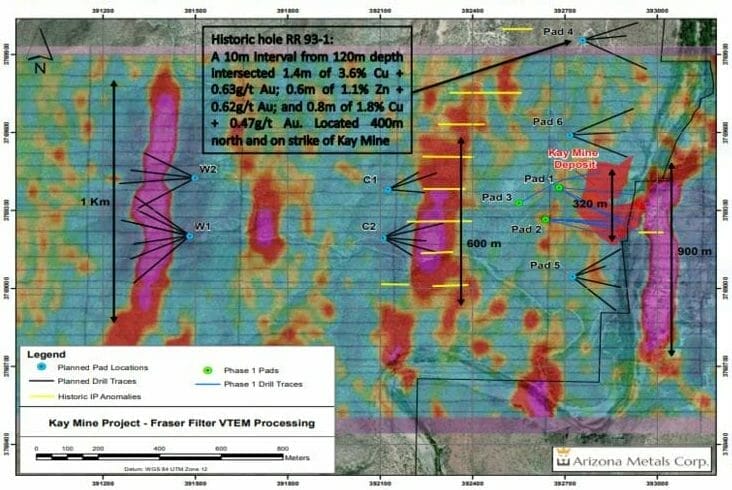
Permitting for pad and road construction at the Central and Western targets (C1 and C2—W1 and W2, above map) was subject to Covid-19 related delays, but is now on track with drilling expected later this year. These targets represent a compelling speculative component to this rapidly evolving (VMS) exploration and development play.
Final thoughts
In previous offerings, I opined that the Company is in an enviable position with two highly sought-after commodities—Gold and Copper—forming the foundation of what promises to be a significant polymetallic resource base.
Quoting a recent Equity Guru article on the subject…
“The grades and intervals tagged deeper down in the system—as evidenced in a May 19th press release—suggest the Company has latched onto a monster deposit, one that may even challenge the granddaddy down the road—United Verde (30Mt at 4.8% copper produced by Phelps Dodge plus an extension that produced 3.5 Mt at 10.2% Cu, 1.3 g/t Au, 58 g/t Ag).”
I have no business doling out investment advice, but if pressed to predict what the future holds for this expertly helmed company, I’d say there’s an endgame in the offing. I suspect this deposit will get taken out by a resource-hungry predator. A successful endgame removes all the guesswork from picking an optimum exit point. Have patience, allow the predator to cash you out.
Hang on to your hats. With an acceleration in drilling—with a 3rd rig now in play—newsflow out of the Kay Mine project could find a whole new gear.
END
—Greg Nolan
Full disclosure: Arizona Metals is an Equity Guru marketing client.
*** An historic estimate by Exxon Minerals in 1982 reported a “proven and probable reserve of 6.4 million short tons at a grade of 2.2% copper, 2.8 g/t gold, 3.03% zinc, and 55 g/t silver.” The historic estimate at the Kay Mine was reported by Exxon Minerals in 1982. The historic estimate has not been verified as a current mineral resource. None of the key assumptions, parameters, and methods used to prepare the historic estimate were reported, and no resource categories were used. Significant data compilation, re-drilling and data verification may be required by a “qualified person” (as defined in National Instrument 43-101 – Standards of Disclosure for Mineral Projects) before the historic estimate can be verified and upgraded to be a current mineral resource. A qualified person has not done sufficient work to classify it as a current mineral resource, and Arizona Metals is not treating the historic estimate as a current mineral resource.

